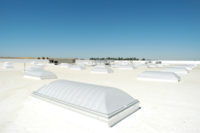Winning the Battle of Energy Savings
Solar is helping to save taxpayer dollars while supporting a facility designed to help save soldiers’ lives.














In 2004, Master Sgt. Mark Rizzo’s U.S. Army convoy was traveling north on a route in Baghdad, Iraq.
“I was in an armored Humvee with a driver, team leader and gunner when we were hit by a roadside bomb. Our vehicle shook, and the driver moved the vehicle to the right of the road, which saved all of our lives,” says Rizzo.
“Our driver acted in a way that helped save us from further attack. He could have easily panicked and ran off the road into a barrier or flipped our 13,000-pound vehicle.
Because he had been trained at the ‘Battle Lab’ and understood the capabilities of the vehicle, he reacted in a way that saved our lives and helped us get through our mission.”
Last spring, the U.S. Army Corps of Engineers, New York District completed the construction of a solar power project to provide energy to the “Battle Lab” or New Jersey Army National Guard Joint Training and Training Development Center.
The project is not only supporting a facility that is preparing soldiers for battle and helping to save their lives, but saving the National Guard and taxpayers considerable money and energy.
The Battle Lab is located at the Joint Base McGuire-Dix-Lakehurst, a United States military facility that is located 18 miles southeast of Trenton, N.J.
The Battle Lab is a one of a kind, high profile, state-of-the-art facility where up to 20,000 military and related personnel from all armed forces agencies around the country come annually to be trained to prepare for battle.
“This is the battle up where soldiers are trained for all types of missions, including stateside missions, like the rescue operations during Hurricane Katrina,” says John Hastings, energy program manager at the New Jersey Department of Veterans Affairs who works with Rizzo, who today is the operations sergeant with the lab.
The soldiers are trained on a number of high-tech training simulators that include live shooting ranges, actual mark-ups of towns in Iraq, and vehicle rollover trainers, which was the training that saved the lives of Rizzo and his team.
According to Hastings, this technology uses considerable energy. The lab uses 1,833,800 kilowatts annually.
Two years ago, the New Jersey Army National Guard asked the Army Corps if it could construct a solar power project to save the National Guard energy and money as the Army Corps had done for it on previous solar power projects.
In May 2011 the Army Corps completed the solar project with the assistance of contractor
P & S Construction of Lowell, Mass. The project consists of a solar photovoltaic power panel array that is mounted on the roof of the Battle Lab’s 128,000-square-foot facility. There are three different roof structures ranging in height from 13 feet to 25 feet above the ground.
The new array covers approximately 71,000 square feet of the roof and was placed next to a pre-existing array that has been providing energy for the lab and was constructed by SunPower of San Jose, Calif.
Panel arrays are composed of modules made up of several solar cells or photovoltaic cells that absorb sunlight that produce electricity. The larger the panel, the more electricity is produced.
Electricity in the form of direct current is produced by the panels, which is not directly usable energy for a building. Most buildings require alternating current at a higher voltage. To make usable building power, the solar panels’ direct current is fed into an inverter that transforms it into alternating current at a higher voltage.
This alternating current power is then sent to the building’s main transformers where it can be used by the building for its energy needs.
“This new array along with the pre-existing array is doubling the amount of energy that is being produced for the lab. Together they are providing nearly 30 percent of the lab’s annual energy needs and saving the National Guard and taxpayers approximately $118,000 annually,” says Jose Diaz, project manager, U.S. Army Corps of Engineers, New York District.
This project is also tied to the public power grid so that excess energy can be shared with the public.
In addition, the project is under the State of New Jersey’s Solar Renewable Energy Certificate Program. Under this program, owners of solar systems connected to the public power grid that generate more than 1,000 kilowatts of electricity per year receive certificates.
These certificates are then publicly sold and traded to New Jersey businesses and individuals, enabling them to receive solar power benefits without building a solar power system themselves. The revenue is returned to the solar system owners.
The New Jersey National Guard expects to generate anywhere from $100,000-140,000 annually in extra income from this facility and, like they’ve done in the past, will reinvest this money to fund other energy-reducing projects at other New Jersey Army National Guard locations.
Diaz says, “I enjoyed working on this project because it makes me feel a sense of pride knowing that these projects will reduce our dependency on foreign oil and will help our country to achieve energy independence, as well as the benefits to our environment.”
He continues, “It’s also great that the Department of Defense is embracing the use of renewable energy and leading the way in the use of these technologies. This was evident at a U.S. Army/U.S. Air Force Energy Forum I recently attended where the motto was ‘Power the Force. Fuel the Fight.’”
This coming fall, the U.S. Army Corps of Engineers, New York District will be completing another solar power project for the New Jersey Army National Guard in Lawrenceville, N.J. It is constructing a rooftop-mounted project on top of the New Jersey Homeland Security Center of Excellence, headquarters of the New Jersey Department of Military and Veterans Affairs. This will complete its seventh solar power system and generate a combined 1.7 megawatts of power with an annual cost savings of $325,000.
Looking for a reprint of this article?
From high-res PDFs to custom plaques, order your copy today!












